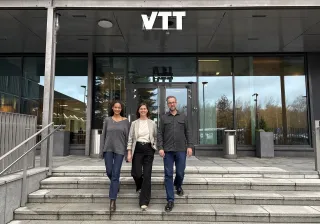Companies around the world are looking for ways to bring people back to the workplace and to build community spirit after a long period of remote work. At VTT, we are building the future of working life through trials and listening to our people. VTTers have been missing social encounters and their community.
We work in a flexible manner, remotely and on-site. Everyone is welcome to the office every day of the week, and can work remotely up to three days a week. This model for flexible work was launched in January 2023.
The need to combine the best aspects of remote and in-person work has been widely recognised but companies worldwide are still looking for the best practices and models for hybrid work.
”VTT is at the forefront of developing new working life. We actively try out models that support collaboration and community spirit, both of which are essential for innovation. Our goal is to make VTT the most meaningful workplace in the world: a place where you can do purposeful work and continuously develop. We also want to provide all VTTers the possibility to experience joy, courage, and curiosity at work. These are the cornerstones of our working culture,” says Kirsi Nuotto, VTT’s SVP for Human Resources.
We have many drivers for building the world’s most meaningful place to work and for experimenting new work models at VTT. These drivers include creativity, innovation work and the impact of our work; learning and development; networks and collaboration; welcoming and integrating new employees; as well as wellbeing and engagement.

Flexible working culture meets VTTers’ wishes
Even before the pandemic, multi-location work was commonplace at VTT. We work at our offices, in laboratories and other research facilities, at client premises, and remotely.
”Being used to attending meetings from different physical locations in Finland was an advantage when we had to switch to maximum remote work at the outbreak of the pandemic. Flexibility is one of the strengths of our culture, and we want to hold on to it,” Nuotto says.
Remote work is often efficient, whilst in-person work fuels creativity, innovation, and stronger interaction. People need other people by their side, also when working. Especially new employees want to know their work community and build networks. VTT has employed about 700 new people during the pandemic.
Hybrid work combines the best parts of remote and in-person work. According to research (materials available in Finnish here), hybrid work improves wellbeing as well as work engagement and satisfaction. At VTT, finding a flexible hybrid work model has been something the employees have wished for, and managers have been committed to.
Lessons learnt during the pandemic guide our way towards the future of work
At the onset of the pandemic in 2020, VTT switched to remote work as much as possible. However, about 400 VTTers continued to work in laboratories throughout the pandemic. Within our New Work @VTT programme, we actively tried out different ways to support our employees’ well-being and sense of belonging to a community during the most intensive remote work period.
”Remote work taught us a lot of good practices. It has significantly helped to maintain a balance between work and leisure and increased the equality between those participating in online meetings, since practically everyone participated remotely. We want to learn from these lessons and create new type of community spirit. We cannot go back to the time before the pandemic, but we do not want to continue working fully remotely like during the pandemic either. We want to create a whole new future of working life and we want to build community spirit, enabling all kinds of encounters. We believe in the power of experimenting, and we will build the future of work step by step, learning along the way,” says Leena Rantasalo, Head of Communications and responsible for the development of VTT's working culture.
We have returned to the office in stages. Our first try was in autumn 2020, when our idea was to work in groups at the workplace, on alternate weeks. Due to a new wave of COVID-19, this experiment was cut short. In 2021, we encouraged our employees to return to the office and to create and agree on practicalities within their teams. Our working conditions were defined by the pandemic, and we followed any relevant health and safety practices.
In 2022, the pandemic subsided, and it finally became possible to return to in-person work. VTTers were missing the encounters at the office, but they were also looking for instructions on the new practices. In particular, team leaders wanted guidelines on how to successfully implement hybrid work. We did not want to define a common, strict model for the entire organisation, but there was a clear demand for a general framework.
Workplace experiment laid foundations for flexible work
VTT started to look for the common frame for flexible work through an in-person work trial in September 2022. During this two-week experiment, the employees were strongly encouraged to work at the office. The number of employees working in-person at different VTT locations increased by about 12% during the experiment.
We diligently observed the work and the general mood of VTTers during the experiment and collected feedback with a survey. Almost 640 VTTers answered, and we collected more than 500 pages of open feedback. People clearly wanted to share their feelings about ways of working.
”It was clear from the feedback that VTTers want to do hybrid work and be at the offices about two days a week, on average. Our VTT-wide hybrid working framework meets these expectations," says Communications Manager Eeva-Liina Kyöstilä from VTT.
VTTers said that they especially miss random and informal meetings with colleagues. They also anticipate in-person work to provide opportunities for joint brainstorming. On the other hand, saving time on commuting was considered the biggest advantage of remote work.
Our employees also reflected on how the office spaces meet the requirements for the new way of working. For example, the number of Teams meetings has clearly increased, highlighting the need for conference rooms and quiet rooms. We have listened to this feedback, and as we move to the new flexible work model, we will be able to specify what further changes are needed.
There’s no return to the old – but let’s not get stuck in the pandemic
VTT's hybrid work is now approaching a stage where both organisational and project teams start to build their own practices within the common framework. The team members decide how to schedule the in-person and remote days and especially what they want to achieve with different ways of working.
VTT supports and encourages the personnel in building the new practices. We have plenty of resources to support flexible work, and VTT has also started a pilot project to learn good practices for hybrid meetings. There are plenty of opportunities for meaningful encounters at the office, and we have already seen that teams are finding and trying out ways to make the most of meeting each other in person.
”The pandemic has changed our way of working permanently, and there is no return to the time before it. This does not mean that we should get stuck to the practices applied during the pandemic now that we do have alternatives. We want to focus on making flexible work serve both our employees and the organisation in the best possible way,” says Rantasalo.
“The best practices are built through dialogue and experiments in everyday life – through actions,” Rantasalo sums up.






